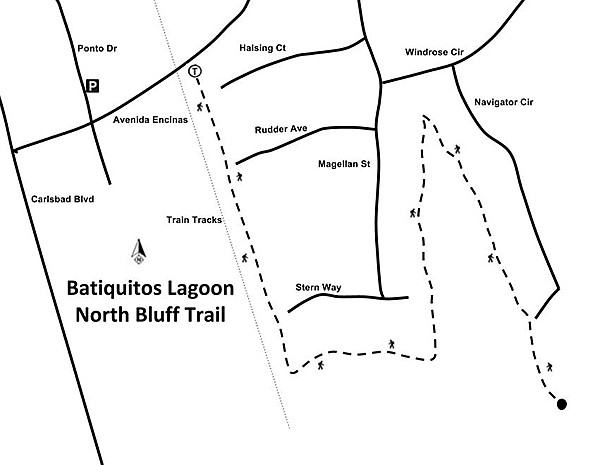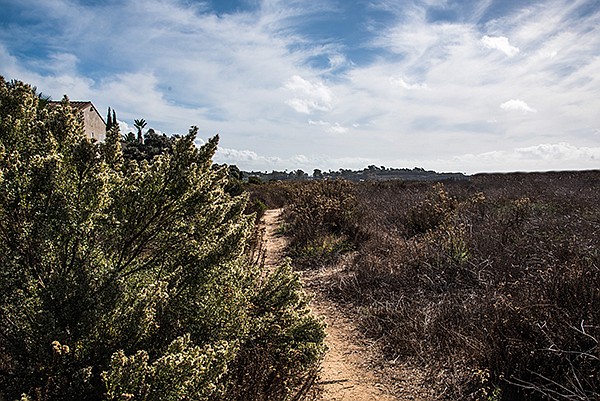 Facebook
Facebook
 X
X
 Instagram
Instagram
 TikTok
TikTok
 Youtube
Youtube

The North Bluff Trail is on a coastal plateau at an elevation of 60 to 100 feet above sea level, overlooking the Batiquitos Lagoon. The plateau once was almost entirely covered by coastal sage scrub habitat, but most of this habitat has been replaced by large suburban housing developments. Only remnants of native vegetation remain. This trail skirts through some of these remnants and in addition offers outstanding, almost aerial, views of the lagoon.

Descend the stairs leading from the trailhead and follow the official trail, which has a decomposed granite surface, and proceed straight south on the ocean side of a wall. Both sides of the trail have been landscaped with nonnative plants, especially myoporum and lantana. Coastal sage scrub vegetation occupies a strip between the landscaped area and the railroad right-of-way. A dirt bike trail parallels the official trail and goes through the coastal sage scrub habitat, joining the official trail when it reaches the bluff overlooking the lagoon.

This trail is important for the perspective it gives on the significance of Batiquitos Lagoon for birds, both seasonal visitors and permanent residents. However, binoculars are necessary if you want to identify most of them. The trail is high on the bluff above the lagoon and does not provide access to the wetlands surrounding the lagoon. You should be able to identify large wading birds, such as great blue herons, egrets, and many flying raptors even without binoculars, but there are so many more birds here. These include 14 species of shore birds, 11 species of waterfowl, 8 species of raptors, and 10 species of flying/diving birds.
Coastal lagoons are flooded valleys, prone to becoming meadows as silt accumulates in the basins due to the erosion of the hills that surround them. This is a natural process known as eutrophication. However, it is greatly accelerated when development in the surrounding watershed flushes a much greater volume of sediment into the body of water. By the 1980s, Batiquitos Lagoon was no longer open to the ocean, so tidal flushing did not remove the sediment washed into the lagoon from the surrounding watershed. The lagoon had almost completely silted up and also had ceased to be a home to most of these bird species.
The least tern (Sterna antillarum), a small flying/diving bird that is white and gray with a black hood, is an extreme example. It is a migratory bird. It is only with us from April, when it arrives from its winter home in the Caribbean and South America, until September. Once abundant, it had become rare — not only here, but also throughout San Diego County and beyond. In 1970 it was designated an endangered species. One of the reasons it is endangered is that it nests in the open, preferably on sandy beaches, where it must compete with humans who also love the beach, especially in summer when the lest tern is nesting on the sand. In the case of the lagoon, these sandy beaches and dunes had been lost as eutrophication occurred.
If human activities had greatly contributed to the endangerment of the least tern, at least in this case we came to their rescue. A number of beaches have been designated least tern breeding areas and humans and their vehicles are prohibited access to them. In the case of the Batiquitos Lagoon, a plan was put into action to save not only the least tern, but also the whole Batiquitos ecosystem. The restoration was completed in 1997. Sediment was dredged from the lagoon, sand bars were created as least tern nesting sites, the wetlands were restored, and the lagoon opened to the ocean to permit tidal flushing. The least tern population has recovered, along with an increase in the population of numerous other birds, and even fish.
Distance from downtown San Diego: 31 miles. Allow 45 minutes. Exit I-5 at Poinsettia and go west. Turn left on Avenida Encinas and travel southwest for 1.5 miles to Ponto Dr. Turn right onto Ponto Dr. and park. Walk back to Avenida Encinas and head east, crossing the bridge over the railroad tracks, to find the trailhead on the southeast side of the bridge.
Hiking length: 1.5 miles out and back. Allow 1 hour.
Difficulty: Easy. Elevation gain/loss is negligible. Leashed dogs and bicycles allowed.


The North Bluff Trail is on a coastal plateau at an elevation of 60 to 100 feet above sea level, overlooking the Batiquitos Lagoon. The plateau once was almost entirely covered by coastal sage scrub habitat, but most of this habitat has been replaced by large suburban housing developments. Only remnants of native vegetation remain. This trail skirts through some of these remnants and in addition offers outstanding, almost aerial, views of the lagoon.

Descend the stairs leading from the trailhead and follow the official trail, which has a decomposed granite surface, and proceed straight south on the ocean side of a wall. Both sides of the trail have been landscaped with nonnative plants, especially myoporum and lantana. Coastal sage scrub vegetation occupies a strip between the landscaped area and the railroad right-of-way. A dirt bike trail parallels the official trail and goes through the coastal sage scrub habitat, joining the official trail when it reaches the bluff overlooking the lagoon.

This trail is important for the perspective it gives on the significance of Batiquitos Lagoon for birds, both seasonal visitors and permanent residents. However, binoculars are necessary if you want to identify most of them. The trail is high on the bluff above the lagoon and does not provide access to the wetlands surrounding the lagoon. You should be able to identify large wading birds, such as great blue herons, egrets, and many flying raptors even without binoculars, but there are so many more birds here. These include 14 species of shore birds, 11 species of waterfowl, 8 species of raptors, and 10 species of flying/diving birds.
Coastal lagoons are flooded valleys, prone to becoming meadows as silt accumulates in the basins due to the erosion of the hills that surround them. This is a natural process known as eutrophication. However, it is greatly accelerated when development in the surrounding watershed flushes a much greater volume of sediment into the body of water. By the 1980s, Batiquitos Lagoon was no longer open to the ocean, so tidal flushing did not remove the sediment washed into the lagoon from the surrounding watershed. The lagoon had almost completely silted up and also had ceased to be a home to most of these bird species.
The least tern (Sterna antillarum), a small flying/diving bird that is white and gray with a black hood, is an extreme example. It is a migratory bird. It is only with us from April, when it arrives from its winter home in the Caribbean and South America, until September. Once abundant, it had become rare — not only here, but also throughout San Diego County and beyond. In 1970 it was designated an endangered species. One of the reasons it is endangered is that it nests in the open, preferably on sandy beaches, where it must compete with humans who also love the beach, especially in summer when the lest tern is nesting on the sand. In the case of the lagoon, these sandy beaches and dunes had been lost as eutrophication occurred.
If human activities had greatly contributed to the endangerment of the least tern, at least in this case we came to their rescue. A number of beaches have been designated least tern breeding areas and humans and their vehicles are prohibited access to them. In the case of the Batiquitos Lagoon, a plan was put into action to save not only the least tern, but also the whole Batiquitos ecosystem. The restoration was completed in 1997. Sediment was dredged from the lagoon, sand bars were created as least tern nesting sites, the wetlands were restored, and the lagoon opened to the ocean to permit tidal flushing. The least tern population has recovered, along with an increase in the population of numerous other birds, and even fish.
Distance from downtown San Diego: 31 miles. Allow 45 minutes. Exit I-5 at Poinsettia and go west. Turn left on Avenida Encinas and travel southwest for 1.5 miles to Ponto Dr. Turn right onto Ponto Dr. and park. Walk back to Avenida Encinas and head east, crossing the bridge over the railroad tracks, to find the trailhead on the southeast side of the bridge.
Hiking length: 1.5 miles out and back. Allow 1 hour.
Difficulty: Easy. Elevation gain/loss is negligible. Leashed dogs and bicycles allowed.
Comments